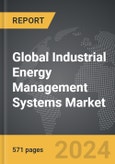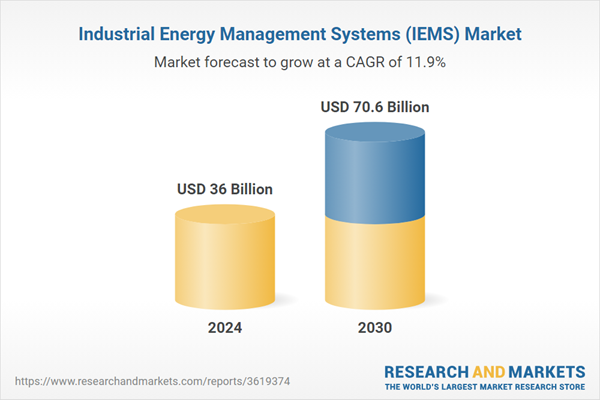Global Industrial Energy Management Systems (IEMS) Market - Key Trends & Drivers Summarized
Why Are Industrial Energy Management Systems Transforming Modern Industries?
Industrial Energy Management Systems (IEMS) are revolutionizing the way energy is managed and optimized across a variety of industries. These systems consist of three primary components: hardware, software, and services, each playing a crucial role in ensuring efficient energy use. The hardware includes devices like sensors, meters, and controllers, which collect and measure energy consumption data. Advanced hardware components can also control equipment directly to reduce energy waste. The software layer serves as the brain of the system, utilizing real-time data analytics, artificial intelligence, and machine learning to generate actionable insights. This software can predict energy needs, optimize usage, and identify inefficiencies across industrial operations. Services, on the other hand, cover everything from system design and consulting to ongoing support and maintenance, ensuring that IEMS are implemented seamlessly and remain functional over time. Together, these components provide a comprehensive solution for reducing energy costs, minimizing carbon footprints, and improving operational efficiency.How Do Industrial Energy Management Systems Apply Across Different Sectors?
The versatility of IEMS extends to numerous applications, each sector benefiting uniquely from its deployment. In the automotive industry, IEMS help manage the energy-intensive processes of manufacturing vehicles, from assembly lines to paint shops, ensuring minimal energy wastage. In the food and beverage sector, energy management is crucial for refrigeration, processing, and packaging, where consistent energy supply and efficiency can significantly reduce costs. Electrical and electronics applications leverage IEMS to manage the energy needs of assembly lines, testing labs, and production facilities, optimizing energy usage without compromising precision. Mining operations, known for their heavy energy consumption, use IEMS to monitor and reduce energy use in equipment like crushers and conveyors. The power and energy sector applies IEMS for balancing energy generation and distribution, ensuring that grid operations are efficient and reliable. The chemicals and petrochemicals industry uses these systems to monitor the energy-intensive processes involved in production and chemical reactions, thereby cutting costs and reducing environmental impact. Other sectors, including cement, pulp and paper, and utility companies, also benefit from IEMS by controlling energy usage in resource-heavy processes, achieving greater energy efficiency and compliance with environmental regulations.What Are the Emerging Trends Shaping the IEMS Landscape?
The evolution of Industrial Energy Management Systems is marked by the integration of cutting-edge technologies and the growing emphasis on sustainability. One of the most significant trends is the rise of smart factories, where IoT devices and big data analytics are enabling real-time monitoring and control of energy usage. Automation and machine learning algorithms are making energy optimization more predictive and less reactive, resulting in fewer inefficiencies. The advent of cloud-based platforms allows for better scalability and accessibility, as companies can manage their energy systems across multiple facilities from a single interface. Cybersecurity has also become a critical focus, as the increasing digitization of energy management systems requires robust protection against potential threats. Additionally, the regulatory landscape is evolving, with stricter energy efficiency and carbon emission standards pushing companies to adopt IEMS. Industries are also exploring renewable energy integration, using IEMS to manage and optimize the use of solar, wind, and other renewable sources in conjunction with traditional energy supplies. This drive for sustainability is further reinforced by consumer and stakeholder pressure, making energy-efficient practices not just a cost-saving measure but a necessity for brand reputation.What Factors Are Driving the Growth in the Industrial Energy Management Systems Market?
The growth in the Industrial Energy Management Systems market is driven by several factors that highlight the increasing importance of efficient energy use and technological advancements. One key driver is the rising energy costs across the globe, which have pushed industries to adopt solutions that can minimize expenses while improving efficiency. The ongoing digital transformation in manufacturing, characterized by Industry 4.0, has amplified the need for intelligent energy management solutions that can work seamlessly with automated and data-driven operations. The push for sustainability and stringent environmental regulations are also significant growth factors. Governments and regulatory bodies are setting aggressive targets for reducing carbon emissions, prompting industries to invest in energy management systems to stay compliant. In addition, the adoption of renewable energy sources, such as solar and wind, is on the rise, and IEMS are crucial for managing the variability and integration of these energy forms into industrial operations. Technological advancements like AI and predictive analytics are making IEMS more effective, encouraging their use across diverse sectors. Furthermore, the increasing complexity of industrial processes, especially in sectors like chemicals, mining, and power generation, has created a demand for sophisticated energy management solutions that can handle high energy loads and provide real-time optimization. Lastly, growing investments in smart infrastructure and the development of new industrial facilities are fueling market growth, as companies look for advanced systems to future-proof their operations and remain competitive.Report Scope
The report analyzes the Industrial Energy Management Systems (IEMS) market, presented in terms of units. The analysis covers the key segments and geographic regions outlined below.Segments: Component (Hardware, Software, Services); Application (Automotive Application, Food & Beverages Application, Electrical & Electronics Application, Mining Application, Power & Energy Application, Chemicals & Petrochemicals Application, Other Applications).
Geographic Regions/Countries: World; USA; Canada; Japan; China; Europe; France; Germany; Italy; UK; Spain; Russia; Rest of Europe; Asia-Pacific; Australia; India; South Korea; Rest of Asia-Pacific; Latin America; Argentina; Brazil; Mexico; Rest of Latin America; Middle East; Africa.
Key Insights:
- Market Growth: Understand the significant growth trajectory of the Hardware segment, which is expected to reach US$42.2 Billion by 2030 with a CAGR of a 11.3%. The Software segment is also set to grow at 12.4% CAGR over the analysis period.
- Regional Analysis: Gain insights into the U.S. market, valued at $11.1 Billion in 2024, and China, forecasted to grow at an impressive 14.1% CAGR to reach $6.0 Billion by 2030. Discover growth trends in other key regions, including Japan, Canada, Germany, and the Asia-Pacific.
Why You Should Buy This Report:
- Detailed Market Analysis: Access a thorough analysis of the Global Industrial Energy Management Systems (IEMS) Market, covering all major geographic regions and market segments.
- Competitive Insights: Get an overview of the competitive landscape, including the market presence of major players across different geographies.
- Future Trends and Drivers: Understand the key trends and drivers shaping the future of the Global Industrial Energy Management Systems (IEMS) Market.
- Actionable Insights: Benefit from actionable insights that can help you identify new revenue opportunities and make strategic business decisions.
Key Questions Answered:
- How is the Global Industrial Energy Management Systems (IEMS) Market expected to evolve by 2030?
- What are the main drivers and restraints affecting the market?
- Which market segments will grow the most over the forecast period?
- How will market shares for different regions and segments change by 2030?
- Who are the leading players in the market, and what are their prospects?
Report Features:
- Comprehensive Market Data: Independent analysis of annual sales and market forecasts in US$ Million from 2024 to 2030.
- In-Depth Regional Analysis: Detailed insights into key markets, including the U.S., China, Japan, Canada, Europe, Asia-Pacific, Latin America, Middle East, and Africa.
- Company Profiles: Coverage of players such as ABB Ltd., AECOM, C3.ai, Inc, Cascade Energy Inc., Cypress Envirosystems and more.
- Complimentary Updates: Receive free report updates for one year to keep you informed of the latest market developments.
Some of the 116 companies featured in this Industrial Energy Management Systems (IEMS) market report include:
- ABB Ltd.
- AECOM
- C3.ai, Inc
- Cascade Energy Inc.
- Cypress Envirosystems
- Eaton Corporation Plc
- Emerson Electric Company
- Enel X S.r.l
- GE Vernova Inc.
- GridPoint, Inc.
- Honeywell International Inc.
- IBM Corporation
- Mitsubishi Electric Corporation
- Opto22
- Rockwell Automation, Inc.
- SAP SE
- Schneider Electric SE
- Setpoint Systems Corporation
- Siemens AG
- Trane Inc.
Tariff Impact Analysis: Key Insights for 2025
Global tariff negotiations across 180+ countries are reshaping supply chains, costs, and competitiveness. This report reflects the latest developments as of April 2025 and incorporates forward-looking insights into the market outlook.The analysts continuously track trade developments worldwide, drawing insights from leading global economists and over 200 industry and policy institutions, including think tanks, trade organizations, and national economic advisory bodies. This intelligence is integrated into forecasting models to provide timely, data-driven analysis of emerging risks and opportunities.
What’s Included in This Edition:
- Tariff-adjusted market forecasts by region and segment
- Analysis of cost and supply chain implications by sourcing and trade exposure
- Strategic insights into geographic shifts
Buyers receive a free July 2025 update with:
- Finalized tariff impacts and new trade agreement effects
- Updated projections reflecting global sourcing and cost shifts
- Expanded country-specific coverage across the industry
Table of Contents
Companies Mentioned (Partial List)
A selection of companies mentioned in this report includes, but is not limited to:
- ABB Ltd.
- AECOM
- C3.ai, Inc
- Cascade Energy Inc.
- Cypress Envirosystems
- Eaton Corporation Plc
- Emerson Electric Company
- Enel X S.r.l
- GE Vernova Inc.
- GridPoint, Inc.
- Honeywell International Inc.
- IBM Corporation
- Mitsubishi Electric Corporation
- Opto22
- Rockwell Automation, Inc.
- SAP SE
- Schneider Electric SE
- Setpoint Systems Corporation
- Siemens AG
- Trane Inc.
Table Information
| Report Attribute | Details |
|---|---|
| No. of Pages | 649 |
| Published | April 2025 |
| Forecast Period | 2024 - 2030 |
| Estimated Market Value ( USD | $ 36 Billion |
| Forecasted Market Value ( USD | $ 70.6 Billion |
| Compound Annual Growth Rate | 11.9% |
| Regions Covered | Global |









